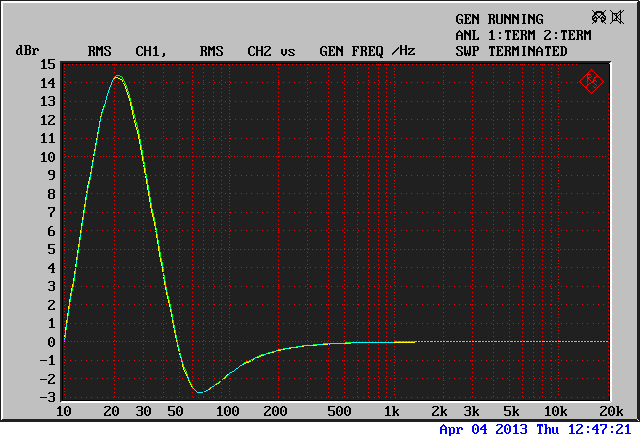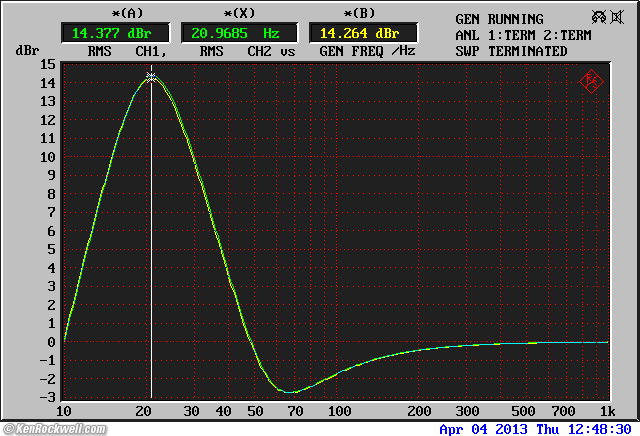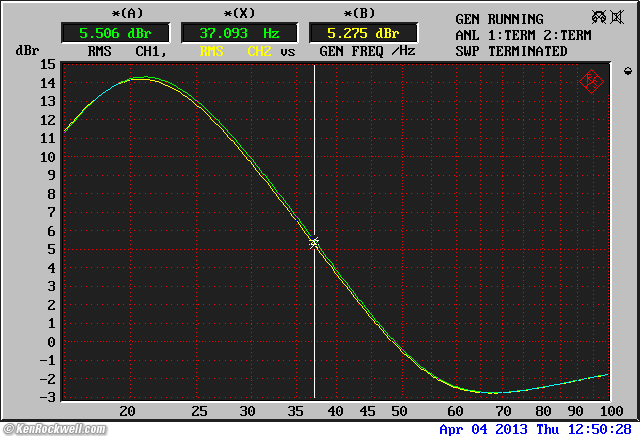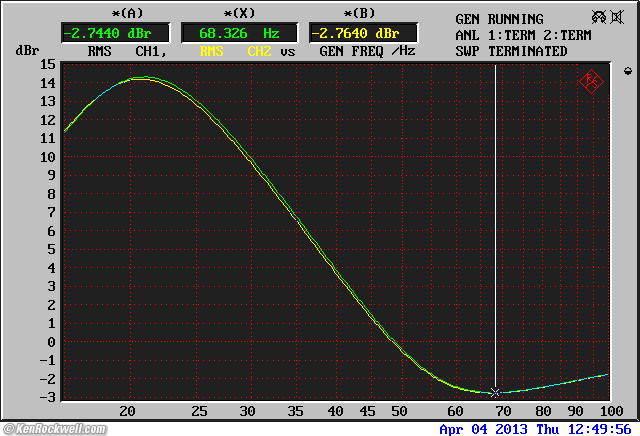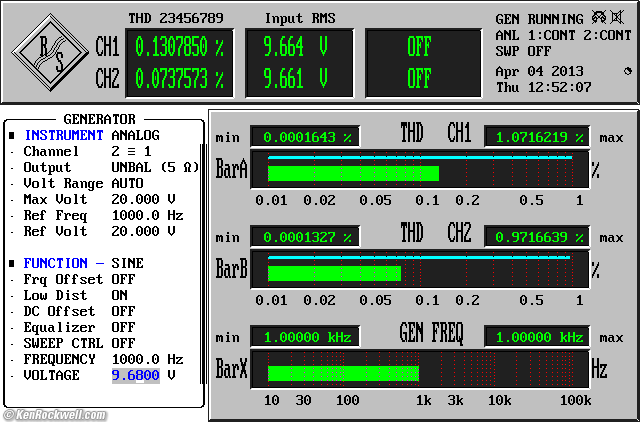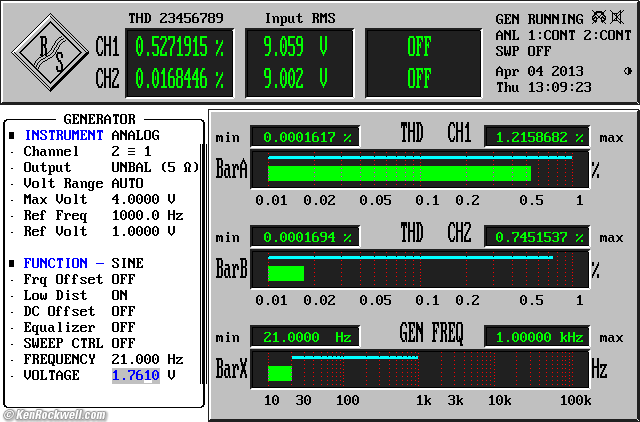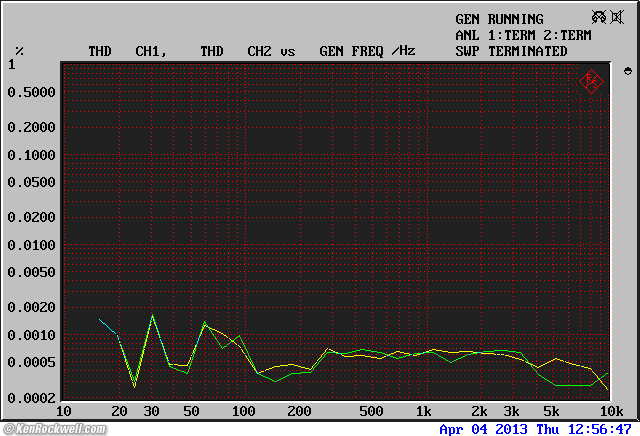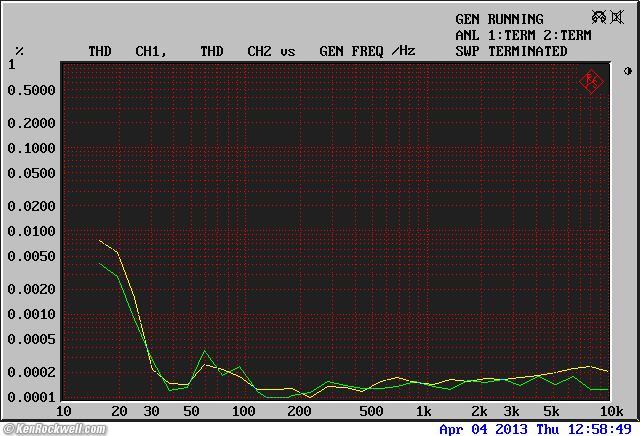Home Donate New Search Gallery Reviews How-To Books Links Workshops About Contact
ADS L990
Loudspeaker (1987-1988)
© 2013 KenRockwell.com. All rights reserved.
ADS L990 (Sealed-box 3-way tower speaker, Dieter Rams styled with perforated metal front grille, 35 " x 11" x 11" with 10" woofer, 1.5" dome midrange and 0.75" dome tweeter, 65 pounds.) This free website's biggest source of support is when you use these links, especially this link to ADS speakers at eBay where they sell for about $250 the pair (see How to Win at eBay) when you get anything, regardless of the country in which you live. Thanks! Ken.
May 2013 Audio Reviews All Reviews
Introduction
The ADS L990 is a small tower loudspeaker with a 10" woofer, 1-1/2" dome midrange and 3/4" dome tweeter — all made in Boston, Massachusetts, USA.
It measures 35 " x 11" x 11" and sits on a short plinth. Connectors are laboratory-standard 3/4" spaced binding posts pointing straight down. You can then run the wires out a slot in the rear of the plinth for neat installation.
It's rated 8 Ω, for amplifiers with rated outputs from 15 W to 200 W peak. It has a tweeter overload protector — but none for its dome midrange or woofer.
It's rated 40 - 25,000 Hz ±3 dB with 88 dB SPL sensitivity at 1 watt at 1 meter.
Its crossover frequencies are 700 Hz and 3 kHz. The high woofer crossover (700 Hz as opposed to 300 Hz) is to limit power to the 1.5" dome midrange.
List price was $2,000 the pair, corrected for inflation in 2013. (That was $975 in 1987 dollars.)
Sound
Sound is extraordinary because of the dome midrange. The dome midrange means that all except the bass is coming from domes, not cones. Cones are subject to all sorts or breakup and resonances, especially from the sound going into the box and coming out again mutilated.
With the dome midrange, there is far less acoustic energy storage and therefore far less potential for temporal colouration.
Balance wise, the L990 is much more neutral than most other ADS speakers. ADS speakers price themselves on their neutrality, but tend to err on the side of bright tweeters.
The L990 has no peaks, it's all quite neutral.
Honestly, for symphonic and vocal music most susceptible to degradation by speaker midrange resonances, I like these L990 about as much as my B&W 801 and Quad ESL63.
The bass is quite good, with more power handing than you'd expect. The tower packs a lot of box volume in very little floor space. Bass is unboomy and with quite a low Fc; about 40 cps.
The 10" woofer is almost as wide as the speaker itself; ADS was very clever in the mechanical and grille design.
The midrange and tweeters are offset from center to distribute the effects of diffraction.
Bass Measurements
In August of 1995 I measured this response with a Radio Shack classic sound-level meter, C-weighted:
+3 dB @ 90 Hz
0 dB @ 55 Hz
-3 dB @ 40 Hz
-10 dB @ 30 Hz
Measuring its impedance versus frequency, I came up with these parameters for a second-order high-pass filter for simulation purposes in the next step:
Left f=39.23 Hz , Q=0.825
Right f=36.10 Hz, Q=0.676
I'm unsure how I came up with these, since I also determined that the Q was a little above 1.
Bass Equalization Network
In 1988, I designed and built an active low-level equalizer to compensate for the L990's phase and frequency response.
This network lowers the speaker's low-frequency response by one full octave and smoothes-out its slight resonance around 67 cps.
This network, based on the work published by Ralph Greiner in the JAES of March, 1983, replaces the L990's low-frequency response with one of a second-order high-pass filter with an Fc of 20 cps and a Qtc of 0.7.
For sanity's sake, I also added an 18 dB/octave low-cut filter at 20 Hz to keep from blowing-out the woofer with any signal below 20 cps.
The completed system works great, with solid response to 20 cps, tighter transient response and no more slight boom in the mid-bass.
Here are 2013 measurements on my 1988 circuit, made on the Rohde & Schwarz UPL:
Frequency Response
Frequency Response, 200 mV input.
Frequency Response, marker at peak response, 200 mV input.
Frequency Response, marker at 37 Hz, 200 mV input.
Frequency Response, marker at 68 Hz, 200 mV input.
Maximum Output Levels (MOL)
MOL at 0.1% THD at 1 kc: 9.662 V RMS, 200 kΩ load.
MOL at 0.1% THD at 21 cps: 9.03 V RMS, 200 kΩ load, 1.761 V RMS input.
Maximum input level at 68 cps is in excess of 10 V RMS.
THD
These are pure THD only, not including noise.
THD with 200 mV RMS input, 200 kΩ load.
THD with 1 V RMS input, 200 kΩ load.
Output noise levels
With input shorted with 5Ω: -98.25 dBV unweighted (22 kc bandwidth), -101.82 dBV A-weighted.
Without 20 Hz high-pass filter
If I bypass the 20 Hz HPF, here are my measurements.
Now it inverts polarity. THD is the same, or a bit less.
Here are the frequency response measurements:
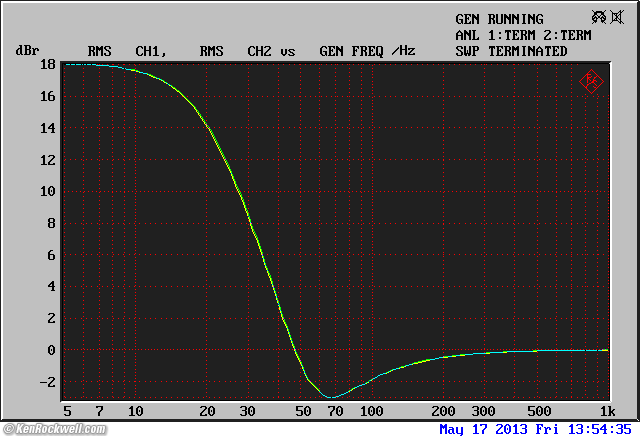
Response, 5 ~ 1,000 cps. (+18.06 dB, or a gain of 8, at DC.)
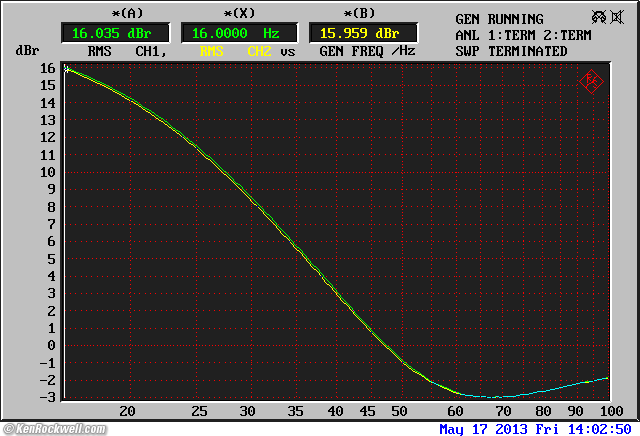
Response, 16 ~ 100 cps.
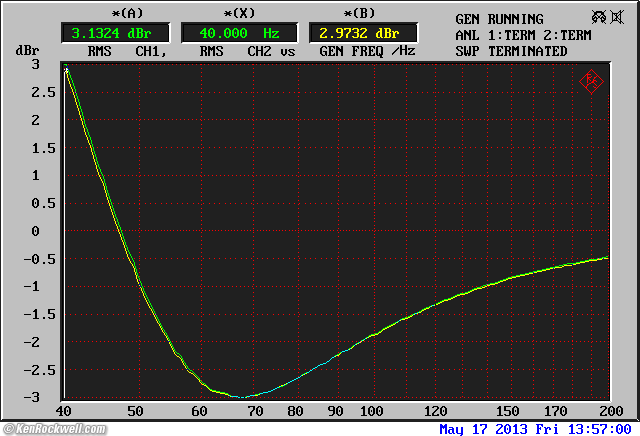
Response, 40 ~ 200 cps.
Frequency |
Network Response |
801 predicted |
801 measured C/flat |
1 kc |
0.0 dB reference |
||
100 cps |
-1.875 dB |
0 dB |
0 dB |
70-75 cps |
+0.2 dB |
+1.5 dB |
|
68.1 cps |
-3.00 dB |
||
60 cps |
(-2.7 dB) |
-0.8 dB |
-0.8 dB / 0 dB |
47.2 cps |
0.0 dB |
||
45 cps |
(+1.0 dB) |
-0.1 dB |
-3 dB |
40 cps |
+3.05 dB |
+0.2 dB |
-4.7 dB / -2.7 dB |
35 cps |
(+5.6 dB) |
+1.4 dB / +4.4 dB |
-6 dB / -3 dB |
32 cps |
(+7.5 dB) |
+2.3 dB / +5.3 dB |
-7 dB / -4 dB |
30 cps |
(+8.5 dB) |
+1.9 dB/ +6 dB |
-8.5 dB / -4.5 dB |
25 cps |
+11.4 dB |
+1.8 dB / + 6.3 dB |
-11.5 dB / -7 dB |
20 cps |
+14.1 dB |
0 dB / +5.5 dB |
-16 dB / -10.5 dB |
18 cps |
+15.2 dB |
-2.9 dB / +5.1 dB |
-20 dB / -12 dB |
16 cps |
+16.0 dB |
-7.1 dB / +1.9 dB |
-25 dB / -16 dB |
15 cps |
+16.4 dB |
||
12.5 cps |
+17.1 dB |
||
10 cps |
+17.6 dB |
||
5 cps |
+18.1 dB |
||
DC |
+18.1 dB |
||
DC gain |
8.04 x |
Cursor (read from graph)
Help me help you top
I support my growing family through this website, as crazy as it might seem.
The biggest help is when you use any of these links when you get anything, regardless of the country in which you live. It costs you nothing, and is this site's, and thus my family's, biggest source of support. These places have the best prices and service, which is why I've used them since before this website existed. I recommend them all personally.
If you find this page as helpful as a book you might have had to buy or a workshop you may have had to take, feel free to help me continue helping everyone.
If you've gotten your gear through one of my links or helped otherwise, you're family. It's great people like you who allow me to keep adding to this site full-time. Thanks!
If you haven't helped yet, please do, and consider helping me with a gift of $5.00.
As this page is copyrighted and formally registered, it is unlawful to make copies, especially in the form of printouts for personal use. If you wish to make a printout for personal use, you are granted one-time permission only if you PayPal me $5.00 per printout or part thereof. Thank you!
Thanks for reading!
Ken Rockwell
Home Donate New Search Gallery Reviews How-To Books Links Workshops About Contact

